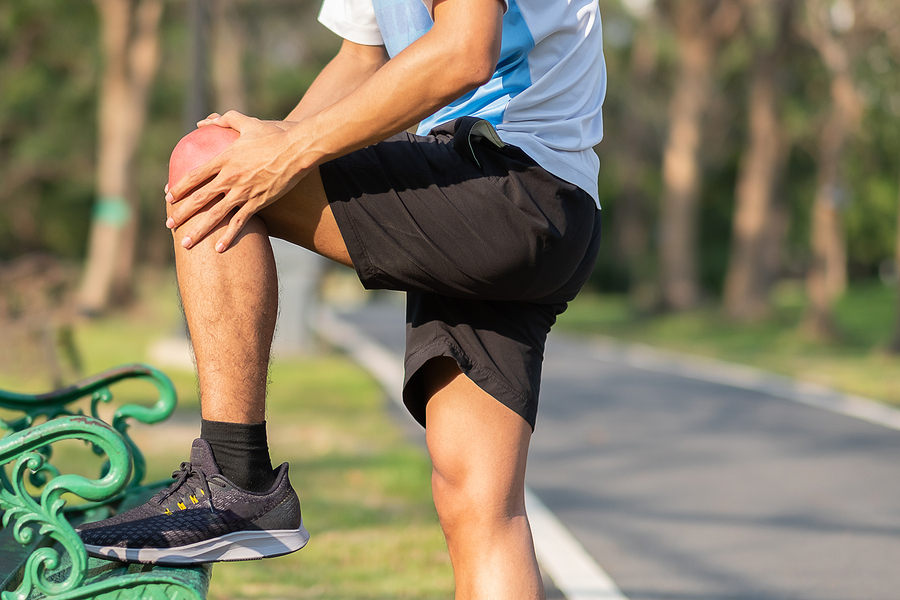Ouch, that hurts!
Keeping fit is so good for us but we sometimes overdo it and the result can be painful
Jan Vickery, Lead Physiologist at AXA PPP healthcare takes us through prevention and treatment of some of the most common sports injuries.
“Reducing the likelihood of a minor injury in the first place is key,” says Jan.
There are a few things to remember:
- always take time to warm up properly before exercising
- try not to train too hard
- try and maintain good all round fitness and have good technique
- make sure to use proper equipment and wear the correct clothing, especially shoes
- stay well hydrated – how to recognise the signs of dehydration
Occasionally though, however careful we are, some injuries are unavoidable. Landing awkwardly, colliding with someone, over twisting or straining can happen to the best of us whilst exercising.
Sports injuries can occur in many ways – here are 5 of the most common along with their symptoms
What is a sprain?
Common sprains mainly occur in our knees and ankles but also in our thumbs and wrists too. A sprain is an overstretching of the band of tissue that connects our bones.
Symptoms of a sprain include pain, swelling, unable to weight bear and ultimately bruising.
What is a strain?
Strains generally occur as a result of jumping or turning at speed and are the stretching or tearing of a muscle.
Symptoms of a strain include continual pain in the area, swelling and/or bruising, muscle spasms and weakness in the muscle.
What is a torn knee ligament?
The ligament which joins your thigh and shin is called the ACL ligament. Its job is to help to stabilise the knee. Damage usually occurs if you land badly after jumping, stop suddenly or rapidly change direction.
Symptoms of a torn knee ligament include pain and swelling, an inability to weight bear, instability of the knee, an inability to bend or straighten the leg.
What is tennis elbow?
If the tissue which joins the forearm muscles to the elbow are strained or overused then this is known as tennis elbow.
Symptoms of tennis elbow include pain on the outside of the upper elbow when you twist your arm, lift, bend or grip.
More information about tennis elbow
What is tendonitis?
More usually affecting the knees, shoulders, thighs, elbows, wrists or fingers tendonitis can occur if the tendons in those areas become swollen and inflamed.
Symptoms of tendonitis include pain, swelling, restriction of movement, weakness or stiffness.
When to seek medical assistance?
You should consider going to your local A&E department, a minor injuries unit or your doctor if you experience immediate swelling, are unable to weight bear, are unable to use the area normally, if you lose feeling, if the area changes colour or goes cold or if the pain is particularly bad.
As these symptoms may indicate a significant injury then X-rays or scans may be needed to correctly diagnose and treat the injury.
However, Jan explains that not all sports injuries start with sudden pain. “Some may start with a minor pain that gets worse over time – this may be an injury that has occurred through overuse. If this type of injury stops you from exercising and your pain is not going away then it is sensible to seek help from your doctor or a physiotherapist.”
How to treat a sports injury
The Rest, Ice, Compression and Elevation method (RICE) is the acknowledged way to treat a minor sports injury.
You can do this yourself by resting the area and applying ice as soon as possible. “Ice will reduce the inflammation,” says Jan. An ice pack (or frozen peas) can be applied for up to 10 minutes every few hours.
“Remember to have a towel between the ice and your skin to eliminate ice burns. If you can, it is also a good idea to elevate the injury as this will reduce swelling too.”
But Jan tells us it is important to keep moving too – “after the initial 48 hours the damaged area should be moved gently as this will encourage the healing process along with preventing any stiffness.”
“You can start gentle exercise when the swelling and pain has subsided and this can take up to a week. But don’t push it, you must take it slowly at first.”
If you need help to manage the pain then an over-the-counter painkiller such as paracetamol or ibuprofen may be taken, if it is safe for you to do so. Your GP could also prescribe more strong painkillers if needed.
A few weeks down the line and you should be back to your usual self but this will depend on the severity of the injury.
Some tips on how to reduce recovery time from minor sprains and strains
- Ice or heat? – as we have just mentioned it is helpful to use ice in the first 48 hours. The use of heat should be avoided in that time as it could cause further swelling. However, after 48 hours heat may speed up recovery by encouraging blood flow to the injury.
- Splints or slings but not for too long – a splint or sling can be useful in supporting the injury as along with reducing pain it can protect the injured part too. However, if you find you need to support or immobilise the injury for more than a week you should seek medical advice as it could be indicative of an underlying problem.
- Are painkillers necessary? – if you are able to take painkillers such as paracetamol and ibuprofen these can help to reduce pain and encourage you to move more.
- Water therapy – swimming or gentle exercises in the pool are safe and great ways to keep fit as they keep you from over straining your body while you recover.
- Don’t do too much too soon – It is recommended that 72 hours is enough rest for the body to promote healing. Once you start to feel better then don’t rush but build up your exercise slowly. Be careful to test out your strength on the recovered area first before running that marathon!
- Prevention is key – It is important to exercise and strengthen other muscle groups to prevent any recurrence of the injury. Physiotherapists tend to recommend pilates exercises as a good way to build whole body strength and flexibility.
Find out about some general self-help tips for pain.
Tips on how to avoid back pain
Top 10 exercises for a healthy back
Disclaimer
All content on Silversurfers.com is provided for general information only, and should not be treated at all as a substitute for the medical advice of your own doctor or any other health care professional. Silversurfers will not be responsible or liable for any diagnosis made by a user based on the content on www.silversurfers.com and we are also not liable for the content of any external websites or links from or to Silversurfers to any other websites. Please always consult your own doctor if you’re in any way concerned about any aspect of your health
Melina - Assistant Editor
Latest posts by Melina - Assistant Editor (see all)
- By yourself at Christmas this year? Tips on how to manage alone - December 16, 2024
- The Silversurfers, just for fun, Christmas Quiz! - December 14, 2024
- 10 potential hazards for pets at Christmas - December 10, 2024
- Christmas Spiced Blueberry Panettones - December 1, 2024
- Three must have toys of the late 60’s - November 24, 2024




















